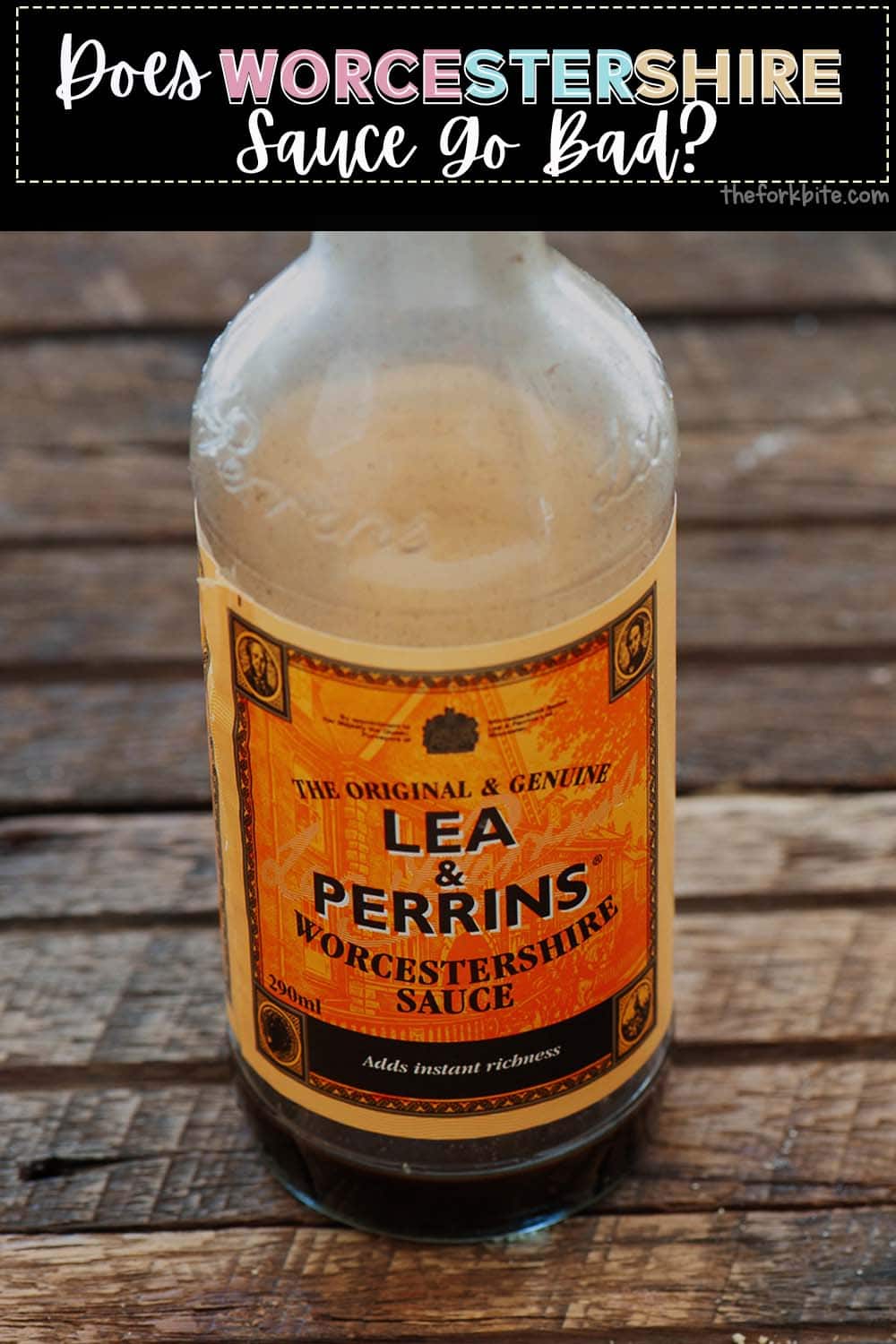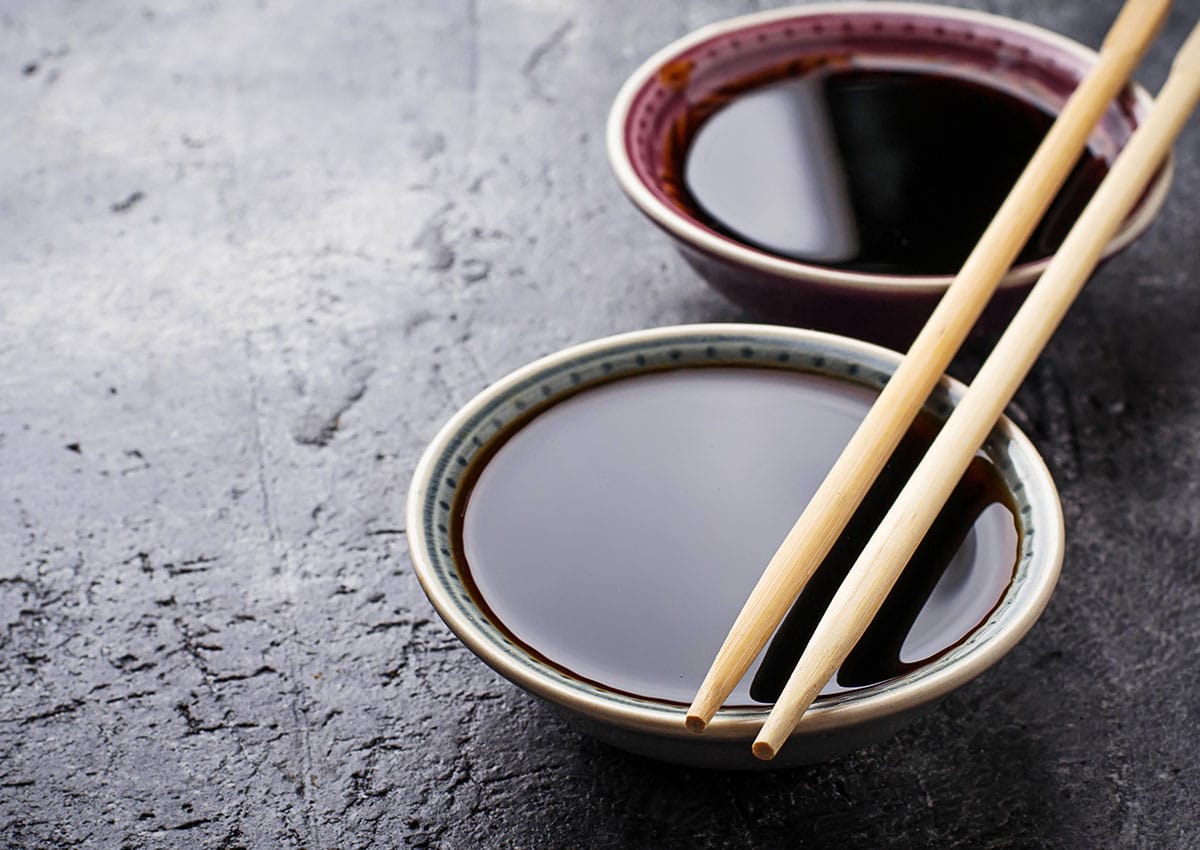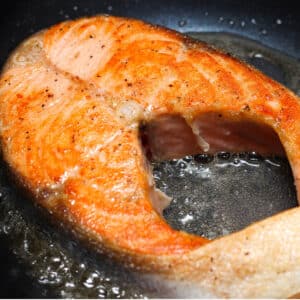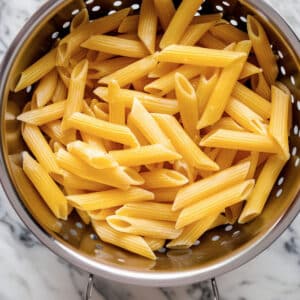Have you found a bottle of Worcestershire sauce lurking in the darkest recesses of your pantry or kitchen cupboard?
Can you remember how long it's been there or for what you bought it? Do you know whether or not it's still safe to use? It's not such a common ingredient, so these are legitimate questions.
Well, you'll be pleased to hear that Worcestershire sauce is very sturdy stuff. It's so sturdy it's pretty sure to be safe to use. However, just like any consumable, it won't last forever.

Jump to:
Perhaps it's time to dust off the bottle, read what it says on the label, and dust upon exactly what this dark-looking sauce is, how long it's likely to be good for, and what recipes you can use it in.
Actually, it's one of my favorite condiments, so allow me to lighten your darkness.
How is Worcestershire sauce made?
Before we go into what this sauce is and how it is made, perhaps you'd like to know how to pronounce it? (It's "Woo-ster-shirr," ). Look at this video and see how many people get it wrong and how it should be pronounced.
Okay, now knowing how to say "Worcestershire sauce," let's talk about what it is and how they go about concocting the mixture.
A perfect example of serendipity
First of all, its origins go all the way back to 1835. Shucks, that's even before the American Civil War! The story is quite nice - a real example of serendipity.
A pair of British chemists, John Wheeley Lea and William Henry Perrins (who form the Lea & Perrins company), worked on a new vinegar-based seasoning and had abandoned one of the batches that didn't quite step up to the mark.
Unbeknown to them, this batch sat there in a dark, cool basement and began to ferment and develop some extraordinary flavors.
Why they went back to it, I don't really know. Perhaps it had never been completely abandoned in the first place.
But go back to it they did, and when they sampled the wonderful complexity of flavor it had developed, they knew they were onto a winner.
What is Worcestershire sauce made of?
Fermentation became a crucial part of the production process. Once it's finished fermenting, it is allowed to stand for a couple of years with the odd stirring now and again.
It is then filtered and bottled. Where did all this take place? In the English county of Worcestershire, of course, but not there are other producers dotted around.
How does it taste?
The taste of Worcestershire sauce is so complex that it is not easy to describe. But I'll have a go anyway.
The base flavor is umami, the fifth taste alongside sweet, sour, salty, and bitter. It is savory and tangy, and I think funky - if you catch my drift.
However, the actual recipe varies a little according to the market for which it is destined.
For example, the version shipped to the US is sweeter than the one consumed by Brits in England.
Over time, it has worked its way up to becoming a staple for making sauces, marinades, and even cocktails like Bloody Marys.
Ingredients of Worcestershire sauce
As you now know, Worcester sauce (an acceptable abbreviation used by the Brits) is a product of fermentation. Its ingredients include:
- Anchovies
- Chili extract
- Cloves
- Garlic
- Molasses
- Onion
- Salt
- Sugar
- Tamarind
There are a couple of other trade secret seasonings in there too. Because it contains anchovies, the original recipe is not suited to vegetarians, vegans, or kosher cuisine.
You can, however, buy vegan, vegetarian, low sodium, and gluten-free variants.
A detailed look at how Worcestershire sauce tastes
It is the vinegar that gives Worcester sauce its tangy zest. It also acts as a preservative which is an essential factor in how long you can keep it.
The anchovy gives the sauce its umami-ness (is that even a real word? - well, it is now.)
But it is the inclusion of tamarind that gives its real unique flavor. The pods, reminiscent of pea pods, only brown, contain a gooey pulp with a wonderful spicy, apricot-date flavor.
I mentioned above that the US version of Worcestershire sauce is sweeter than the one sold in the UK.
It's because the UK version is distilled with malt-vinegar, whereas the US counterpart uses white vinegar.
The American variant also has three times the level of sugar and sodium.
Signs that Worcestershire sauce has gone off
If you do something silly with Worcestershire sauce, such as leaving an open bottle adjacent to a heat source, it can go off.
However, you can keep an unopened bottle well past its "best before" date by several years.
An opened bottle can be safely stored in your pantry for up to one year, whereas if you keep it in a fridge, it will be okay for up to 3 years.
Note:
Don't worry if you spot some sedimentation at the bottom of the bottle. If it's been left to stand for quite some time, this is quite normal. It is quite safe to use. Just shake the bottle to mix the contents up.
It's not difficult to tell when Worcester sauce has gone bad, and that is what is up for discussion next.
Here are the 3 signs:
1 Appearance of mold
The appearance of mold on foodstuffs is never a good sign, and this also includes Worcestershire sauce.
If you don't close the bottle tightly after using it, you may notice spots of mold appearing around the bottle's opening after some time. If this happens, throw it away.
2 Strange smell
Worcester sauce has a pretty strong aroma, but you may notice that the smell is much weaker after a while. It is because the air has got at it, and it has started to degrade.
If it is allowed to degrade further, the odor could become rotten or sour if this is the case, into the bin with it.
3 Buildup of gas
The usual giveaway sign that all is not well with your Worcestershire sauce is when the bottle begins to puff up.
If you were to open the bottle, you would probably hear a whoosh of escaping gas or a distinct popping sound. Such a buildup of gas can occur in both the plastic or glass bottle variants.
Obviously, the glass bottle won't puff up as a plastic one will. However, you will still get that whoosh or pop when you open the bottle; if there has been a gas buildup - bin it.
Does Worcestershire sauce go bad?
More about Worcestershire sauce's shelf life.
I touched briefly on the shelf life of Worcestershire sauce at the beginning of the section on "tell-tale signs" it has gone off. But I'd like to explore that a little further with you.
Let's start with the fact that Worcester sauce has been aged in the bottle for around 18 to 24 months before it ever reaches the shelves of grocery stores and supermarkets.
We know that even after its printed shelf life of two or three years, if left unopened, it can stay good for many years - some say up to ten.
Of course, there are different manufacturers around, and each one's ingredients and processes may vary a little, so it is safe to say that, on average, a bottle of Worcester sauce will last for five years beyond its best before date.
To enjoy your Worcester sauce at its very best, it is recommended to consume it within two or three years of its purchase.
Remember that once you've opened a bottle, it will start to deteriorate more quickly but still be good for many years.
Recommended ways of storing Worcester sauce
- According to the manufacturers, Worcester sauce is best stored in a cool, dry place. That means it's okay in a kitchen cupboard as long as it's nowhere near a heat source, or even better, in a pantry.
- The key to stopping mold from appearing near the bottle's opening is to give it a quick wipe using a piece of paper kitchen towel after use and then reseal it tightly.
- Once you've opened your bottle, make sure to reseal it tightly. Then, you've got two options. It can then be stored in a cupboard or pantry, or to preserve its shelf life longer, in a fridge.
Great things to do with Worcestershire sauce
Because Worcester sauce has such a powerful savory hit to its flavor, you can add it to any dish that benefits from good spicy seasoning.
It's quite powerful stuff so use it sparingly. A couple of tablespoons in a casserole for four is plenty.
It works brilliantly in dressings, marinades, and sauces; you can even sprinkle it onto a burger to bring out that wonderful umami taste.
It partners beautifully with casseroles, stews, and soups, and it is great with cheese sauce and when sprinkled on top of toasted cheese - yum!
You can make cheese on toast to the next level with Welsh Rarebit. Ever heard of it? It's even got its very own special day of the year. Click here to find out more.
Then, of course, there's the Bloody Mary.
1 Bloody Mary - the cocktail with a bite and more
Bloody Mary, or its non-alcoholic cousin, Virgin Mary, just wouldn't be the same without a liberal sprinkling of Worcester sauce.
It is often used as a "hair of the dog" drink. The full version of this strange phrase is "the hair of the dog that bit you."
It's the Worcester that gives a Bloody Mary ts bite. If you are a glutton for punishment, you can add a dash of tabasco too.
Bloody Mary isn't the only cocktail associated with Worcestershire sauce. Others include:
- The Prarie Oyster - the original hair of the dog concoction
- The Vampiro
- The Bloody Bull.
There are many others too. Check them out on the barnonedrinks.com website.
2 Marinade for fish and meat
This devilishly good sauce works brilliantly as a marinade with all sorts of fish and meat. You can use it as a substitute in any recipe calling for soy sauce.
It's a sort of soy sauce with attitude - a big attitude. Used as a marinade, all you do is drizzle a few drops onto the fish or meat, then leave to marinate for a couple of hours. Maybe less with fish as it will begin to cold cook.
The vinegar in Worcester sauce (the thing that can cold cook fish) works to soften meats like steaks, and the sugar counteracts the acidity.
You can also add a few herbs of your choice, such as basil, oregano, or thyme.
3 Adding to soups
If you stumble across an opened bottle of Worcestershire sauce that has been in your fridge for goodness knows how long, and you want to make use of it, providing it hasn't gone off, it makes a great addition to soups.
It works well in pumpkin soup and can spice up the cream of tomato soup. It goes great with chicken noodle soup, vegetable soup, and many others - anything that will benefit from a spicy umami kick.
If you make a pot full of soup and you've got some leftover, you can even freeze it. You'll find that freezing and thawing does very little to diminish the Worcester sauce hint of flavor.
4 A vital ingredient of barbecue sauce
Many barbecue cooks in the US like to use Worcester sauce straight from the bottle to douse meat and fish before grilling. Others Add to store-bought barbecue sauces. Either way, it works a treat.
It is also used in other sauces like shrimp cocktail sauce. Here is a great recipe you might like to take a look at.
You can store both barbecue and shrimp cocktail sauces in a glass container in your fridge for up to two weeks. You can even freeze them you want to for up to three months.
5 Buying Worcester sauce in powder form
If you're not keen on the idea of storing Worcestershire sauce for a long time, you can buy it in powder form.
It's the real McCoy - it's just been dehydrated, and in an unopened packet, stored in a cool, dry place, it will keep for years.
It's convenient. It takes up little room, and when you want to use it, just add boiled water, and away you go. You can even use it as a rub!
The product reviews I have read say it is even more intense in flavor than the bottled variety, so careful as you go.
Different types of Worcestershire sauce
I mentioned earlier; there are many different types of Worcester sauce on sale here in the US. To recap, they include:
1 Gluten-free.
Many people here in the US have taken to gluten-free diets, so this version, made with white vinegar rather than malt, is ideal.
2 Vegan and veggie-friendly.
The anchovies in the original recipe make it out of bounds for vegans or vegetarians, so the manufacturers produce this vegan and veggie-friendly variety.
3 Low Sodium.
A lot of health-conscious people are careful to try and limit their salt intake. This variant is especially for them.
My favorite is, of course, the original; however, all of the other varieties are pretty tasty too.
The best way to discover the one that suits you and your palate best is to work your way through them all.
Shopping for Worcestershire sauce
You won't have any problems locating Worcester sauce when you go out shopping. You'll find it in the condiment section of most grocery stores and supermarkets.
It is usually stocked in 10-ounce bottles.
If you are careful about buying foods with artificial additives and preservatives, you'll find that Worcestershire sauce is made with mostly natural ingredients, but you should always read the label.
Does Worcestershire sauce tenderize meat?
As I mentioned earlier, Worcester sauce is used as a marinade, and it contains the necessary ingredients to act as a meat tenderizer.
Because of its lovely deep, rich taste, it has no trouble working its way into any meat or poultry.
If like me, you are a lover of the umami flavor, once you start using Worcester sauce as a tenderizer, you'll never look back.
A guide to marinating steaks with Worcester sauce
I've used this method for marinating steaks in Worcester sauce for many years, and I can promise you it works wonderfully well.
What you'll need:
- Some steaks
- Ziploc bag, a ceramic or glass bowl
- between half to one cup of good old Worcestershire sauce.
Here's what to do:
Step 1
Put the stakes into a Ziploc bag or a glass or ceramic dish, whichever you prefer, and pour over the Worcester sauce.
Step 2
Set aside and leave to marinate for at least 30 minutes. I recommend leaving it for as long as two hours if you're not in a rush. Turn the steaks from time to time to make sure they are evenly coated.
Step 3
Remove the steaks from the Ziploc bag or bowl and pat dry with a paper kitchen towel.
Step 4
Place onto a hot skillet or grill and cook them the way you like them.
Can you freeze Worcestershire sauce?
It is possible to freeze Worcestershire sauce, but you have to ask yourself why you want to?
Stored in the right way, it will last for several years. Another reason for asking the question is that it is hard to freeze due to the salt molecules, though not impossible.
I have heard that some people like to marinate their stakes in Worcester sauce and then freeze them. These guys reckon that the meat takes on a more intense flavor.
Another thing that some people do, particularly bartenders, freeze Worcestershire sauce in ice cube trays before adding to an appropriate cocktail, like a Bloody Mary.
I must say that I prefer to use it straight from the bottle, but hey - everyone to their own.
Rare health problems that can be caused by Worcestershire
I have to say that I love Worcestershire sauce, but given the intensity of its flavor, I'm hardly ever likely to consume an amount that will cause a problem.
But I guess if you're a Worcestershire sauce addict, being a high sodium concoction if you were to drink too much, it could cause heart and kidney disease, high blood pressure, and even stroke.
If you are a Worcester sauce addict, then I suggest it might be a good idea to purchase the low sodium variety mentioned earlier.
Some people could suffer a rare allergic reaction due to the anchovies in Worcestershire sauce.
The symptoms of allergy can include:
- Indigestion.
- A shortening of breath.
- A tightening of the throat.
- Redness of the face.
If you or someone you know suffers from such a fish allergy, then your best use the vegan/vegetarian option from which the anchovy has been removed.
What are the alternatives to Worcestershire sauce?
Given its unique taste and intense new umami flavor, nothing comes up to scratch in terms of an alternative.
You can always try making your own, of course, but why bother when the bottled stuff is so good anyway? But if you want to, you can play around with the ingredients I mentioned earlier.
Another alternative is something like HP sauce. It's good, but not that good.
Another possibility is to add a good quality beef or mushroom concentrate, but again it will not have the intensity of real Worcester sauce, and to my mind, it wouldn't go well in your bloody Mary.
But as they say, it's horses for courses. After all, it's a free world.






